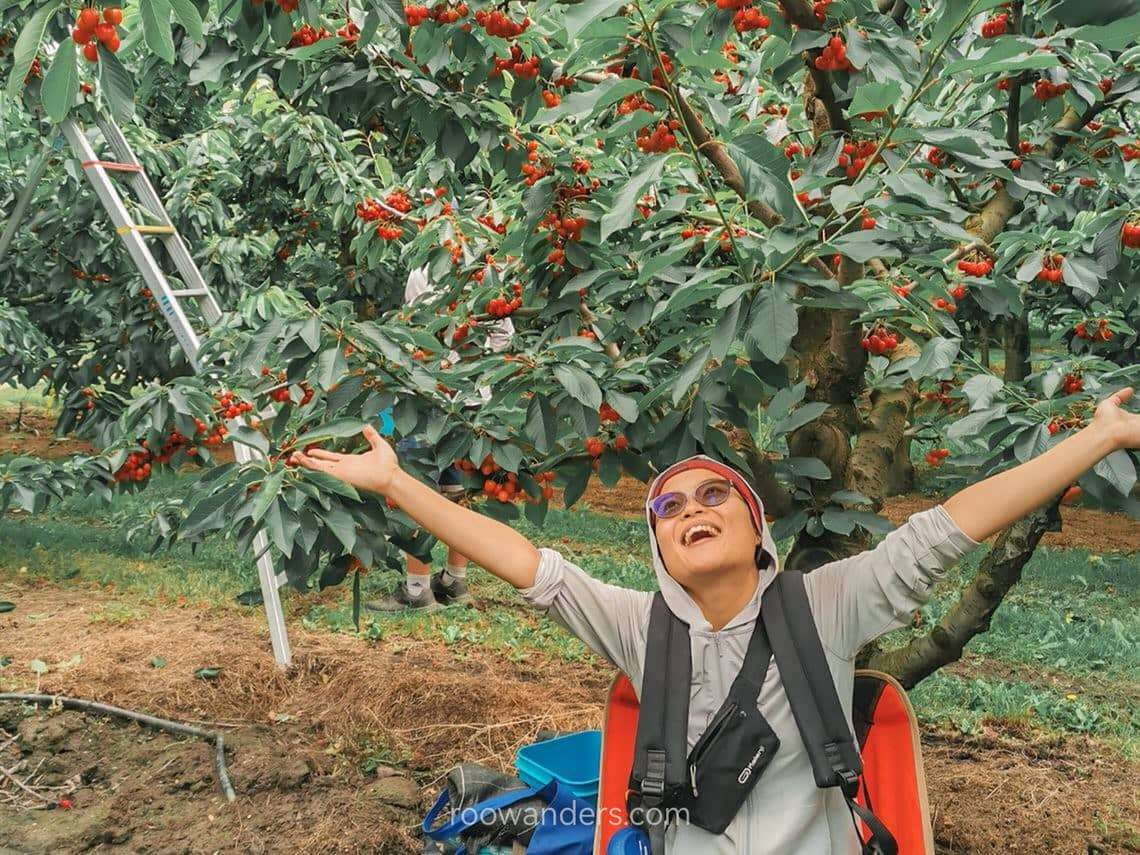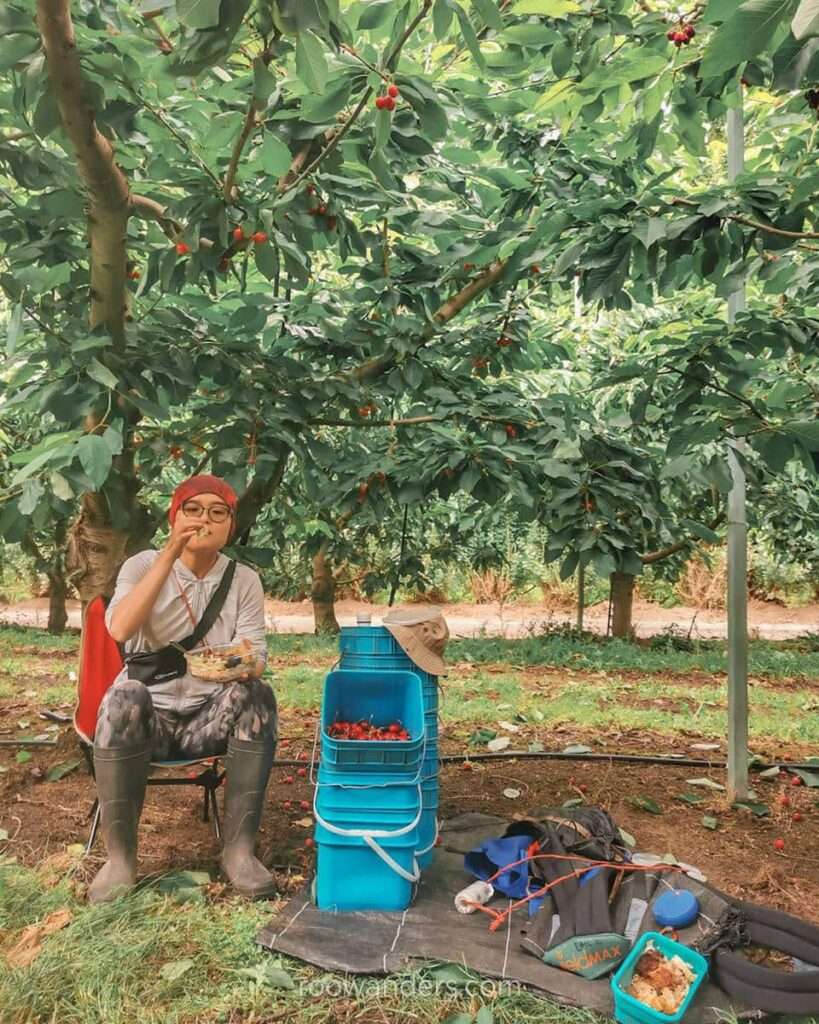
New Zealand Holiday Job #7: Cherry Picking
Sigh, picking cherries. How romantic. Imagine roaming around the acres of trees heavy with ripe, juicy dark rubies for your taking.
Sorry to burst your bubble folks! If you are here to learn the secrets to earning loads as a cherry picker in New Zealand, I am sorry to inform you that I am just not cut for fast picking! How can you do it fast when the cherries all look so tasty? This post will just be another breakdown of the job from my perspective.
Picking or packing cherries isn’t as beautiful as most other working holidaymakers imagine. Work can be tough with heavy lifting and hyper-stretching at high heights.
I did cherry picking in Clyde from Dec 2020 to Jan 2021. Post may be updated periodically.

Where are the Orchards?
Cherry trees demand lots of sunlight and low humidity. Your best bet is to travel to Central Otago in the South Island or Hawke’s Bay if you’re in the north. Sunny, arid land tends to be favourable for vineyards too.
Most cherry orchards in NZ are in Cromwell, with 45 South being the biggest producer of NZ export-quality cherries. There are orchards in Alexandra, Clyde, and Roxburgh too. But Roxburgh is kinda far from many amenities…
Apart from cherries, Cromwell also produces other stone fruits such as apricots and peaches. It is known as the capital of stone fruits in NZ – versus the capital of kiwi in Te Puke!
When does the season start?
The cherry season usually begins around December and until the end of January or early February.
Orchards start recruiting for pickers and packers as early as October. Mark your calendars!
Why is picking cherries so popular?
Hmm, maybe it’s because you get to stuff yourself silly with nature’s lollies while picking. Essentially getting paid to stuff yourself silly with cherries.
Otherwise, if you are a fast picker who can pick over three buckets an hour, you may cash in more than the minimum wage.


Cherry pickers earn by contract rates, which means your earnings are tied to the buckets of cherries you pick every day. A filled bucket weighs about 5 kg. A fast picker who can pick above the minimum hourly rate would earn a bonus.
However, not all orchards would have the same bucket rate for cherries, as it depends on the species and the ease of stripping them off the trees.
Packing cherries tend to be mundane factory work, and you earn only the minimum wage. I heard from packers that the packhouse is cold, and you have to constantly dip your fingers in icy water used for rinsing and lowering the core temperature of cherries. The perks of packing, however, are stable working hours. But no cherries from pickers due to bad weather mean no job for packers too.
An average day as a cherry picker
The day begins early at 7 am. Rise and shine; this is summer when the sunlight hits your face at 6 am or even earlier.

It tends to be cold in the morning, with the mercury hovering around 10°C. But the temperature can soar to as high as 30°C in the afternoon. Cherry trees tend to rain dew drops early in the morning, and the cherries can be too cold to pick. Most pickers would wear a few layers and adjust their attire depending on the weather. Proper sun protection is important from late morning till the end of the workday.

If there was rain the night before, a helicopter might be called in to fly over the orchards and dry the wet leaves. A huge ceiling fan in action! Some orchards might have massive built-in fans to dry the cherries.
Wet cherries split when you pick them. Split cherries contain mould and ooze disgusting slime.
If we were starting the day in a new orchard, we would pick our ladders from the truck, grab a few buckets from the bucket crate and go to our allocated row of trees. The supervisor would brief us on the desired size and colour of the cherries to pick. Sometimes, we would get a circle tattoo on the back of our palms to guide us in our picking.

Each picker is given a personal wearable bucket holder and a groundsheet to bring to work every morning. Empty or filled buckets are placed on the sheet to reduce soil contamination on the delicate fruits.
The picker may pick the cherries within his reach before resorting to the ladder. Most good cherries are at the top, so no running away from climbing the ladder!

As with any job, we get two smokos and a lunch break for a typical 8-hour work day. Smokos and lunch are always within the orchard, so pack a simple lunch that does not need reheating and lots of water. When nature calls, off you go searching for the portable toilet hidden somewhere within the orchard. They smell terrific at 30°C.
The workday ends when the supervisor yells Last Bucket. We would finish up the bucket we are holding and pass it to the bucket runners nearby.
Verdict
Picking cherries is an interesting job to try, but not a job that would bring in lots of hours or money. The work is weather dependent, which in NZ is highly unpredictable. However, you do get the daily cherry buffet.
As with training hops in my previous job, this is outdoor work that exposes you to the elements. It can get cold in the morning and blistering hot in the afternoon on the same day. A couple of days of rain would leave muddy paths between the rows of trees and make ladder placement a chore.

Cherries are delicate fruits that split and rot after a couple of days of rain. In fact, my work as a cherry picker ended a month earlier than expected due to bad weather. Rain tends to cause split cherries that rot quickly.
If you’re trying to earn loads as a cherry picker, you need to be fast, have a sharp eye for colours, and be a bit of a risk-taker on the ladder to get as many cherries as possible. Some pickers were standing or sitting on the top row to reach the biggest cherries at the canopy. Knowing the best ladder placement helps too. Some pickers wrap their thumbs and index fingers with medical tape to prevent blisters from forming. Your nails would turn black from dust and debris.
Dunstan Hills Ltd (DHL)
I worked with DHL in Clyde, about 30 mins from Cromwell. DHL – not the shipping company! – is generous and takes good care of its staff. It is a shame that my work with them ended early due to bad weather.
Not all companies give their staff paid holidays. A few other orchards, such as CentralPac do not. Some may make their staff go on a two-week break from Christmas eve to after the New Year.
DHL paid us and even gave us Christmas gifts. We were also given rent-free weeks for workless days.

Ending
So, if you’re keen to be a cherry picker, here are some takeaways that may be useful to you;
- Gumboots. Invest in a pair. The Warehouse sells them at NZD 18. My boots lasted for a year before they fell apart. You would need them again for your next outdoor or farm work where there’s mud or poop.
- Hat, long-sleeved shirt, sunglasses, and sunblock. Stay cool under the cancer-inducing sun.
- Big water bottles. Stay hydrated.
- Lunch boxes. Keep lunch simple since you cannot heat them. Make sure you keep them under the shade, or the humidity and temperature may turn them sour.
- Carrying the ladder. The ladders are effing heavy. The best way to carry them around is to stand between the legs of the ladders and hold both sides as you walk like an A-formation.
- Keep your bucket holder and ground mat tidy. Roll the mat and slot it between the rings of your holder.
- Bring along a speaker. If you do not want to wear earpieces or headphones for long. But some pickers may not like it.
- Have audiobooks or podcasts ready. Get paid while listening to books or commentaries.
And to end it off, you will see lots of dead birds in the orchard. Some were shot, some were tangled in traps, and some fell from nests. Birds love to roost in orchards since food is plentiful. Orchards cast traps and hire shooters to scare or kill birds. But this also means you will get to see nestlings when you are up in the ladders amongst the trees!









